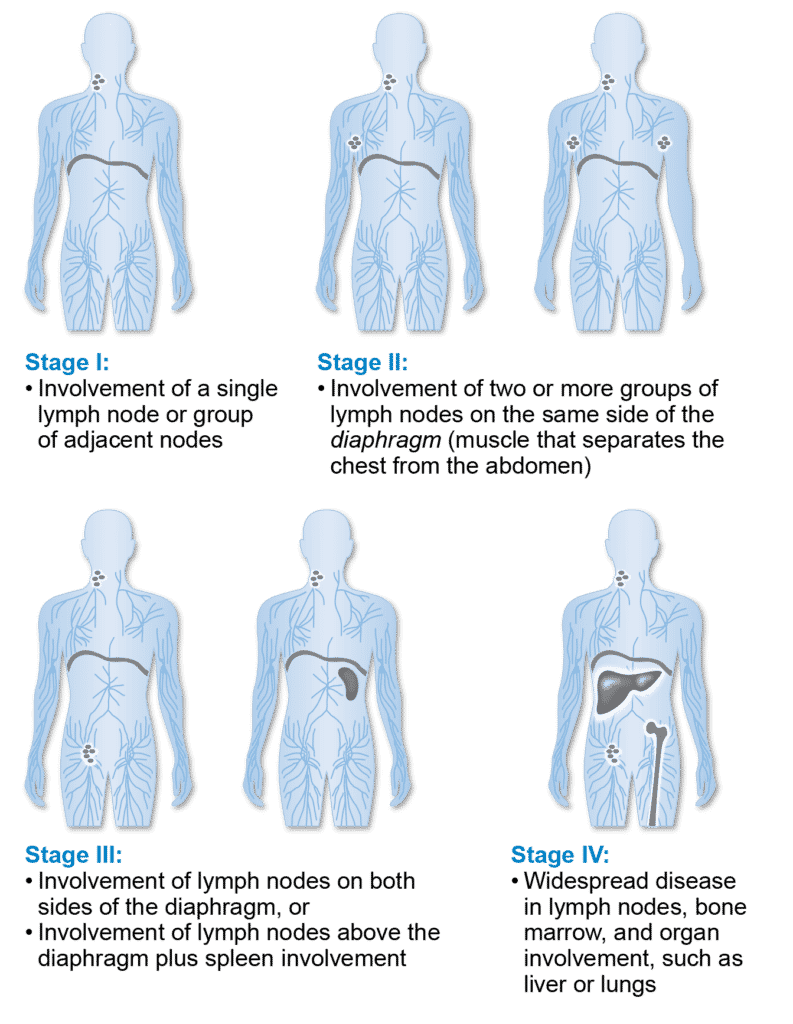
Treatment Options
Staging and Prognosis

Staging is used to describe how widely the lymphoma has spread in patients. Doctors use the stage of disease, along with test results and other factors, to decide the best time to begin treatment and what treatments are likely to be the most effective for each patient.
Staging for Hodgkin and Non-Hodgkin Lymphomas
The Ann Arbor staging system and its modification called the Lugano Classification (see below) are used for staging Hodgkin lymphoma (HL) and non-Hodgkin lymphomas (NHL), including small lymphocytic lymphoma (SLL). Designed by the Roman numerals I through IV, this staging system divides the body in half using the diaphragm, the muscle that divides the chest cavity from the abdominal cavity. In children, Hl is staged using a different system in which the lymphoma is classified as low-, intermediate-, or high-risk.

Your doctor may also add any of the following single letters to the stage.
- A – if patients have not experienced symptoms such as significant weight loss (more than 10 percent in six months), drenching night sweats, or fevers
- B – if patients have lost weight (more than 10 percent in six months) and have experienced drenching night sweats or fevers
- X – if patients have a lymphoma that is greater than 10 cm (4 inches) wide. This is also called bulky disease
Remember that advanced stages of lymphoma are curable, unlike advanced stages of solid tumor cancers, which are more difficult to treat.
Staging for Chronic Lymphocytic Leukemia
Because of the way that blood and bone marrow are involved in chronic lymphocytic leukemia (CLL), the staging systems for CLL are different from those used for HL and NHL, including small lymphocytic lymphoma (SLL). Patients with CLL are staged using either the Rai staging system or the Binet classification system. Doctors in the United States tend to use the Rai system, while the Binet system is more popular in Europe. See examples below:
The Rai Staging System for CLL
| Stage | Description | Risk Group |
| 0 | Blood lymphocytosis (increased lymphocytes) No anemia (decreased red blood cells) and no thrombocytopenia (decreased platelets) | Low |
| I | Blood lymphocytosis and enlarged lymph nodes No anemia and no thrombocytopenia | Intermediate |
| II | Blood lymphocytosis and enlarged spleen (splenomegaly) and/or enlarged liver (hepatomegaly) No anemia and no thrombocytopenia | Intermediate |
| III | Blood lymphocytosis Anemia (hemoglobin less than 11 grams per deciliter) | High |
| IV | Blood lymphocytosis Thrombocytopenia (platelets less than 100,000 per microliter) | High |
The Binet Classification for CLL
| Stage | Description | Match-up with Rai System |
| A | Less than three of five possible enlarged areas No anemia and no thrombocytopenia | Rai stages 0, I, and II |
| B | Three or more of five possible enlarged areas No anemia and no thrombocytopenia | Rai stages I and II |
| C | Any number of possible enlarged areas Anemia and/or thrombocytopenia | Rai stages III and IV |
Prognosis
Prognosis is the medical term doctors use for predicting how the disease will progress and the likelihood for recovery. Prognosis is usually based on information gathered from hundreds or thousands of other patients who have had the same disease. This statistical information provides doctors with a general idea of what to expect when a patient is diagnosed with a specific type of lymphoma, and also gives guidance on the kinds of treatments that have been most successful in treating that cancer.
Keep in mind that no two patients are alike and that statistics from large groups of people cannot accurately predict what will happen to a specific patient. The doctor most familiar with the patient’s situation is in the best position to help interpret these statistics and understand if and how they may apply in a patient’s particular situation.
Helpful Resources:
